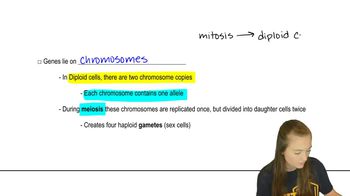Table of contents
- 1. Introduction to Genetics51m
- 2. Mendel's Laws of Inheritance3h 37m
- 3. Extensions to Mendelian Inheritance2h 41m
- 4. Genetic Mapping and Linkage2h 28m
- 5. Genetics of Bacteria and Viruses1h 21m
- 6. Chromosomal Variation1h 48m
- 7. DNA and Chromosome Structure56m
- 8. DNA Replication1h 10m
- 9. Mitosis and Meiosis1h 34m
- 10. Transcription1h 0m
- 11. Translation58m
- 12. Gene Regulation in Prokaryotes1h 19m
- 13. Gene Regulation in Eukaryotes44m
- 14. Genetic Control of Development44m
- 15. Genomes and Genomics1h 50m
- 16. Transposable Elements47m
- 17. Mutation, Repair, and Recombination1h 6m
- 18. Molecular Genetic Tools19m
- 19. Cancer Genetics29m
- 20. Quantitative Genetics1h 26m
- 21. Population Genetics50m
- 22. Evolutionary Genetics29m
17. Mutation, Repair, and Recombination
Types of Mutations
Problem 28b
Textbook Question
Textbook QuestionYeast are single-celled eukaryotic organisms that grow in culture as either haploids or diploids. Diploid yeast are generated when two haploid strains fuse together. Seven haploid mutant strains of yeast exhibit similar normal growth habit at 25°C, but at 37°C, they show different growth capabilities. The table below displays the growth pattern Hypothesize about the nature of the mutation affecting each of these mutant yeast strains, including why strains B and G display different growth habit at C37°C than the other strains.
 Verified Solution
Verified SolutionThis video solution was recommended by our tutors as helpful for the problem above
Video duration:
2mPlay a video:
Was this helpful?
Key Concepts
Here are the essential concepts you must grasp in order to answer the question correctly.
Haploidy and Diploidy
Haploidy refers to cells that contain a single set of chromosomes, while diploidy indicates cells with two sets. In yeast, haploid strains can mate to form diploid cells, which can undergo meiosis to produce haploid spores. Understanding the difference between these two states is crucial for analyzing genetic mutations and their effects on growth under varying conditions.
Recommended video:
Guided course

Diploid Genetics
Temperature Sensitivity in Mutants
Temperature sensitivity in mutant strains refers to the phenomenon where certain mutations affect the organism's ability to grow or function at specific temperatures. In this case, the mutant yeast strains exhibit normal growth at 25°C but show varied growth capabilities at 37°C, suggesting that the mutations may impact protein stability or enzymatic activity at higher temperatures.
Recommended video:
Guided course

Mutations and Phenotypes
Genetic Interaction and Epistasis
Genetic interaction occurs when the effects of one gene are modified by one or several other genes. Epistasis is a specific type of genetic interaction where the expression of one gene masks or modifies the expression of another. This concept is essential for hypothesizing why strains B and G display different growth habits at 37°C, as their mutations may interact differently with other genetic factors affecting growth.
Recommended video:
Guided course

Interacting Genes Overview

 9:49m
9:49mWatch next
Master Point Mutations with a bite sized video explanation from Kylia Goodner
Start learning


